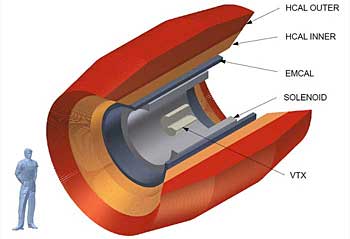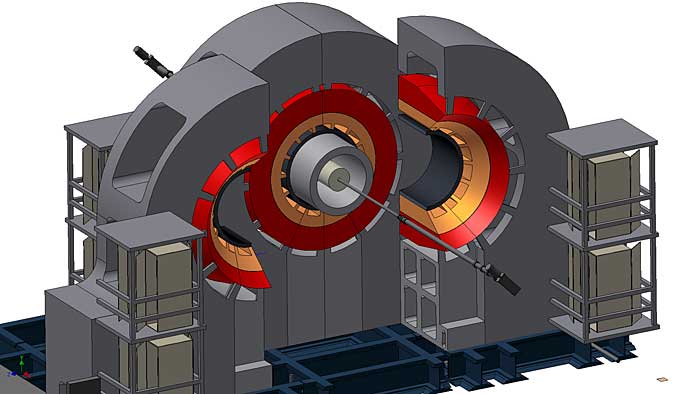The sPHENIX Proposal
August 6, 2012
By John Haggerty, Dave Morrison and Jamie Nagle

A rendering of the sPHENIX upgrade showing the inner silicon tracker (VTX), the solenoid, and the calorimeters. The solenoid has a diameter of 1.4 m.
In October 2010, the PHENIX Collaboration published its plan for future experimentation, detailing key physics questions for study at RHIC over the next decade (the PHENIX Decadal Plan can be found on the PHENIX website). A few weeks ago, on July 1, 2012, the collaboration completed months of work and submitted to BNL management a proposal for a greatly upgraded PHENIX detector which we call sPHENIX. This detector enables a compelling physics program that will address fundamental unanswered questions about the nature of the strongly coupled Quark-Gluon Plasma (QGP), discovered experimentally at RHIC to be a perfect fluid. We have posted the main part of the sPHENIX proposal as a preprint.
These questions include how and why the QGP behaves as a perfect fluid in the vicinity of strongest coupling, near the temperature at which the phase transition takes place, whether there are quasiparticles that play an important role in the dynamics of the QGP, and how the strongly coupled QGP evolves to become a weakly coupled system at asymptotically high temperature.
These questions can only be fully addressed with a detector which can measure jet production and jet properties at RHIC energies, at temperatures near the phase transition where the coupling is strongest and by comparing these measurements to higher temperature QGP measurements at the Large Hadron Collider. Taken together, these data will provide valuable insight into the thermodynamics of Quantum Chromodynamics (QCD), the theory which governs the interactions of the quarks, the building blocks of nuclei.
Free quarks have not been observed experimentally, but the result of quarks being produced and interacting with each other has been observed in many experiments as "jets," or collimated bundles of relatively long-lived particles such as pions which are observable in the laboratory. By measuring the jets in RHIC collisions as surrogates for the quarks, we can study how quarks interact with the medium of perfect fluid.

A depiction of sPHENIX, showing how it would sit in the current PHENIX experimental hall— with plenty of room to spare
The sPHENIX concept reuses much of the existing PHENIX infrastructure - such as the gas handling, electronics, computing, and safety systems - and it incorporates some key innovations in materials and sensor technology developed in just the last few years. This careful balance of reuse and novelty has enabled us us to design an extremely compact and economical detector, while still enabling fantastic physics reach. The experiment is based around a high field (2T) solenoidal magnet, enabling us to keep the diameter of the magnet small (1.4 m, or less than five feet) and thus minimizing the size and mass of the detectors outside the magnet, while still allowing high resolution tracking measurements in the magnetic field. Outside the solenoid are the detectors which add unique capability at RHIC, the system of electromagnetic and hadronic calorimeters, providing us a precise measure of the energy and direction of the electrons, photons, and jets produced in RHIC collisions. Both PHENIX and STAR have electromagnetic calorimeters, which allow us to identify and measure the energy of electrons and photons by fully absorbing their energy, but sPHENIX would add a hadronic calorimeter which can do the same for the strongly interacting particles like pions which are the major component of the jets. That requires a lot more material to absorb their energy, and so the hadronic calorimeter sets the size and scale of the detector.
We also aim to keep the detector as compact as possible by using a new kind of photodetector, a "silicon photomultiplier" or SiPM, which operates at low voltage and can work in the fringe magnetic field of the solenoid, and is much smaller than an actual photomultiplier tube. This technology is being tested by a group on STAR and with a DOE "Small Business Innovative Research"(SBIR) grant that PHENIX collaborators Craig Woody and Edward Kistenev were awarded last year. We plan to build on our existing electronics and computing architecture, which will allow us fully utilize the luminosity of the recently upgraded RHIC facility.

Workfest in progress at the University of Tennessee, Knoxville
Working through the physics arguments and crafting a practical design for the detector has taken a large and sustained effort by the whole collaboration, something which has taken place while simultaneously operating PHENIX and successfully installing the current round of upgrades to the detector. This has been done in a series of monthly weeklong "workfests" (Figure 3) which have been held at the University of Colorado, Columbia University, Florida State University, the University of Tennessee, and BNL. At the workfests, we have refined the physics case, tried to match the physics to the detector design, simulated the physics processes and the detector, and begun the long process of optimizing the detector design. This culminated in a final push to write and edit a lengthy document which describes the proposal in some detail.
Don Lynch, PHENIX's lead engineer, and Richie Ruggiero, our designer, have been working with the detector groups to develop concepts for construction and assembly of the detector in the PHENIX hall. A rendering of the upgraded detector is shown in Figure 1 and its incorporation into the PHENIX interaction region is shown in Figure 2. The next steps in this process are to continue work on the physics case and detector design, and to begin the process of reviews by the laboratory and the DOE, and to test small prototypes of both calorimeters.
The sPHENIX upgrade we have proposed represents a major scientific instrument with key new physics capabilities, and crucially, it provides the foundation for a much broader physics program, much of which was described in detail in the PHENIX decadal plan. Its physics capabilities can be augmented in the future through modest incremental upgrades that have been an integral part of the design considerations from the outset, but it has significant potential to extend our understanding of the QGP over the next decade.
The specific future options considered for installation inside the solenoid magnet are additional charged particle tracking outside the existing PHENIX silicon vertex detector (VTX) and a preshower with fine segmentation in front of the electromagnetic calorimeter. The possibility of extending the sPHENIX capabilities has attracted international interest. For example, RIKEN has expressed very strong interest in providing additional charged particle tracking outside of the existing PHENIX silicon tracker. These future additions will expand the sPHENIX physics program to include: (a) heavy quarkonia suppression via the three upsilon states, (b) tagging of charm and beauty jets, (c) jet fragmentation function modifications, (d) nuclear suppression of π0 yields up to pT = 40 GeV/c, and (e) a possible low mass dilepton program. The open geometry of the magnetic solenoid also allows for a forward angle spectrometer upgrade option aimed at measuring photon, jet, and lepton observables relevant to answering questions in p(d)+A collisions about cold nuclear matter and in transversely polarized p+p collisions about transversity.

About the authors: Jamie Nagle is a professor at the University of Colorado; Dave Morrison and John Haggerty are physicists at Brookhaven National Labortatory.
The design for a future Electron Ion Collider (EIC) at RHIC consists of adding a 5-30 GeV electron beam to the current hadron and nuclear beam capabilities. The proposed initial construction would consist of a 5-10 GeV electron beam, referred to as Phase 1 of eRHIC. We have designed sPHENIX so that it would also serve as the foundation for a future EIC detector, referred to as ePHENIX. The sPHENIX proposal, covering |η| < 1.0, when combined with future upgrades in the backward (η < −1.0) and forward (η > 1.0) regions is compatible with a full suite of EIC physics measurements.
2012-3264 | INT/EXT | Newsroom









